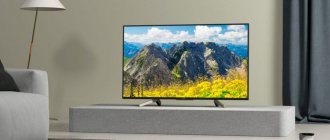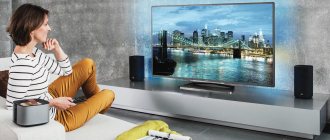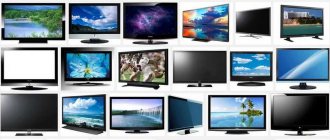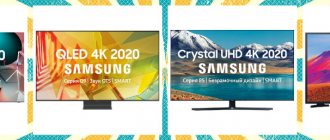Modern TV technologies are changing dynamically towards better picture quality, sound and functionality. After a sharp jump in the dollar exchange rate, many Russian buyers have become limited in their budget and, accordingly, in their choice. But which of the innovations advertised by manufacturers really qualitatively distinguish expensive models from budget ones, and which are purely a marketing ploy? The rating of the best TVs for 2021 according to the Mark.guru portal will help you figure it out.
Criterias of choice
- Evaluate the key comparison parameters, this will help you choose the best model for you:
- Screen diagonal. Usually, this is the first place to start choosing. Depends on individual preferences and room size.
- Display technology. This could be an LCD TV with an LCD screen, a more modern LED with LEDs, or the latest developments of OLED and QLED, the best in image quality. Plasma TVs are less popular.
- Screen resolution. Regular HD 720p is worth choosing for small models, since there will still be no difference in them compared to FULL HD and 1080p resolution. The latest development is ULTRA HD 4K 3840x2160. However, there is virtually no content in this resolution right now, and it is unlikely to appear in the next few years. Therefore, on an ultra-expensive 4K TV you will watch a maximum of FULL HD pictures.
- Update frequency. Shows how many times per second the picture on the screen is updated. Affects the quality of display of dynamic scenes. It is better to take with a frequency of 120 Hz.
- Color range. As a rule, TVs use the NTSC format with a color reproduction of 16 million colors. Some manufacturers offer improved color gamut, but the difference is practically indistinguishable to the human eye.
- Screen shape. The widely advertised curved screen, according to many, is just a publicity stunt, and the realism of the image is largely affected by the resolution.
- Availability of Smart TV. Assumes the ability to connect to the Internet to access additional content and functions.
- Availability of connectors. It is better to take models with several USB and HDMI, so that it is convenient to connect additional equipment.
What should you expect besides voice assistant or HDR?
The 2018 version of CES showcased the technological features of HDR well. While there are good reviews for HDR 10 as the base format, no one is forgetting about Technicolor's HLG and Advanced HDR, which have a place on the scene.
A standard called Dolby Vision is actively vying for entry into the premium category. However, Samsung, in collaboration with other companies, created HDR10-plus as an alternative.
Alexa voice assistants have already appeared on some of the presented TVs, and this even affected Android models. This is largely due to the slow rollout of Google Assistant for them.
For better or for worse, Apple refused to participate in CES. This means that visitors did not see new tricks from Siri. But they are interested in whether Roku and LG are capable of becoming explorers of outer space. Another news of the exhibition was the presentation by Samsung of a product called Bixby (a proprietary voice assistant).
From 90 thousand rubles
The price for models diagonally larger than 55 inches exceeds 90 thousand rubles. This is not surprising, because to achieve a clear image for this screen size, you will need the most modern and expensive technologies. Therefore, the best models are presented only by the world's leading brands.
1LG OLED55C6V
LG holds the leadership in the most technologically advanced and expensive segment.
This is a model with a 55-inch diagonal curved OLED screen, an ultra-thin body and an almost invisible frame.
The image on it is incredibly detailed and realistic. Here, in addition to the usual functionality, there is 3D technology and 4 speakers with a total power of 40 W, as well as a number of automatic video and sound optimization systems.
Advantages:
- best image quality;
- excellent sound;
- Magic Remote;
- functionality.
No deficiencies found.
The average price is 130 thousand rubles.
Prices for LG OLED55C6V:
2Sony KD-65XD7505
The main advantage of this model is the incredibly large screen diagonal of 65 inches. At the same time, you will fully experience all the delights of 4K high-definition images. If functional bells and whistles are not important to you, then you can safely buy this TV. It has excellent picture and sound, has a Smart TV, satellite and digital receiver and other necessary functions. Unlike the previous model, there is no 3D support, less powerful sound and simpler Direct LED display technology.
Advantages:
- large screen;
- high-quality image;
- good functionality.
No deficiencies found. The average price is 108 thousand rubles.
Prices for Sony KD-65XD7505:
3Samsung UE55JU7500U
The 55-inch model from Samsung completes the list of expensive models. This is a 4K TV with a curved screen, 3D support and a full range of modern features. It is characterized by good color rendition, high contrast, realistic and detailed images. Speakers with a subwoofer with a total power of 40 W create deep surround sound.
Intelligent backlight automatically reduces the intensity in dark areas and increases the intensity in light areas, creating an optimally realistic picture.
Advantages:
- excellent picture and sound;
- functionality;
- convenient setup.
No deficiencies found.
The average price is 98 thousand rubles.
Prices for Samsung UE55JU7500U:
Will users be pleased with 8K TVs this year?
We have already seen the presentation of many prototypes at various exhibitions, not least of which is CES.
But today, the recent implementation of the HDMI 2.1 standard has made 8K TVs a reality. Japan-based Sony has filed an application to register the 8K HDR logo along with the trademark, which will be used for large format television receivers. This means we cannot rule out the possibility of Sony launching its first 8K TV.
At the same time, a message appeared in the Korean media about Samsung introducing its Micro LED TV with a 150-inch screen. This is the first TV model to have 8K resolution. But LG, in order to launch the production process for producing 8K OLED panels on a large scale, needs to launch new workshops. And this is not at all easy to do.
TV technology at CES 2021
For movie fans who gave themselves a projector, flat panel, or some other home theater element for the New Year holidays, it is better not to read our January news. After all, with the last volleys of festive fireworks in Las Vegas, CES traditionally opens - the largest forum of consumer electronics, where developers clearly demonstrate the backwardness of yesterday's flagships and present mega-advanced new products rushing to replace them.
For several years now, LG OLED panels have reigned supreme in the field of matrix development for high-end TVs. Is it any wonder that the main television sensation of Las Vegas was associated with this brand. In front of a huge crowd of journalists, the first truly roll-up TV was revealed to the world. The technical characteristics are quite in the spirit of the times: the matrix, of course, is OLED, 65-inch diagonal, 4K resolution. The model is experimental, but with the advent of serial devices capable of completely dissolving into the interior, the developers promise not to delay it.
And not just OLED
It seems that most manufacturers have finally come to terms with the leadership of LG’s “organic” products, and only Samsung is persistently trying to promote original solutions. But if in the past two years the emphasis was on proprietary QLED technology (essentially, a variation of LCD with backlight improved in brightness and spectral qualities), now we are talking about a fundamentally different imaging system, called microLED. In it, each subpixel is a traditional inorganic LED. The solution would seem obvious, but its implementation was previously hampered by difficulties with the production of subminiature luminous crystals.
Now Samsung engineers have managed to reduce the size of a single emitter to 100 microns, that is, approximately the diameter of a human hair. Such progress has made it possible to create a 146-inch TV with a color gamut approaching the BT.2020 standard and a peak brightness of up to two thousand lumens - neither OLED nor LCD panels have such beauty yet.
The prototype was called TheWall - “Wall”, since its panel is a seamless assembly of universal LED modules. From them, like fragments of a mosaic, you can put together a screen of the desired shape and size on the wall - another innovation unprecedented for home theaters.
The bright prospects for microLED progress are clouded only by the fact that even a hundred micrometers is still too much for a luminous point on a home screen. The resolution of “The Wall” has not been officially announced, but on the sidelines there was talk about 4K - for 146 inches this is far from a record, and panels with diagonals of 65 - 85” more suitable for DCs will most likely not be built on such a matrix. So we are waiting for an answer to the key question: do developers have the reserves to further reduce inorganic diodes?
8K on the horizon
But “organics” and good old LCDs have no problems with pixel packing density. No sooner had the video industry really started to embrace ultra-high resolution than the 8K logo began to appear more and more often in press releases of leading brands, denoting a picture with a simply extreme pixel resolution of 7680 x 4320.
LG was again the loudest in this regard at CES, presenting a prototype of an 88-inch OLED TV. Its appearance not only states the possibility of creating organic TV panels with extremely high resolution, but also confirms the reality of producing matrices with a diagonal of more than 77 inches (the current limit for serial OLED models).
Another extremely interesting 8K prototype was presented by Sony. Its 85-inch screen is based on liquid crystals, the powerful backlight system of which is capable of delivering a peak brightness of up to 10,000 lumens. For TVs, this is an absolute record, corresponding to the maximum value provided for by the most advanced HDR standard for this indicator, Dolby Vision.
A new version of the proprietary X1 video processor, called X1 Ultimate, is responsible for image processing in the device. The performance of the new chip is approximately twice that of the current version of the X1 Extreme, and is capable of not only processing an 8K signal in real time, but also highlighting individual objects in frames for their selective correction. By the way, Sony’s new mass-produced 4K TVs will also gradually be switched to this megaprocessor.
Before an 8K picture appears on the screen, the signal must somehow get into the TV, and in addition to the HDMI 2.1 we have already described, a new way has appeared for this. Seeing growing interest from developers, the VESA alliance, just in time for the exhibition, published certification standards for Display Port cables capable of handling 8K signals. They will be marked with the DP8K logo, and applicants for it are already being released.
Do all these announcements mean that those who have not yet bought a 4K TV need to hold their horses and wait for the mass appearance of ultra-ultra high-resolution equipment? In no case. For the most part, 8K equipment is at the level of early prototypes, designed to show where progress can take us in the fairly distant future. Or not bring it - depending on your luck. The Japanese, however, have already been lucky - they started testing broadcasts in 8K last year, and Sharp managed to introduce the serial Aquos LC-70X500 TV for the domestic market. But even in the Land of the Rising Sun, the full-fledged commercial implementation of the new technology will take more than one or two years, because by and large there are no transmission channels, no media, no content for it, and video cameras around the world can literally be counted on one hand.
HDR – powerful and many-sided
High dynamic range imaging has become one of the main drivers of video technology development. Today, even game consoles and some smartphones are compatible with HDR.
True, it is a little alarming that the number of signal encoding formats continues to steadily increase. In recent months, HDR10+ has begun to gain momentum, differing from its predecessor HDR10 in the presence of dynamic metadata, which makes it possible to more accurately convey the brightness range of individual scenes in one film. Well, a newcomer can contrast Dolby Vision, which is similar in capabilities, with two extremely important points: the openness of the platform and the absence of licensing fees. It's no surprise that the number of HDR10+ supporters is growing rapidly. In addition to the main adherents of 20th Century Fox, Panasonic and Samsung, Amazon and Warner Bros., among others, announced support for the format at CES.
However, while the new technology is at the stage of technical demonstrations, Dolby is using every day to strengthen the position of its proprietary format, which is already familiar to both film distributors and viewers. Shortly before the start of the exhibition, the first Ultra HD Blu-ray discs with films in Dolby Vision (for example, Despicable Me 3, Fast and Furious 8 and Atomic Blonde) finally went on sale.
Sony announced in Las Vegas its first player for their playback, the UBP-X700, thus joining LG, OPPO and Panasonic. The latter, by the way, brought to CES the world’s first TVs with HDR10+ support, as well as the UB820 disc player, capable of playing not only the latest releases in Dolby Vision, but also those not yet published in the “plus” format. In turn, Samsung announces the imminent release of firmware that will add compatibility with last year’s models of UHD BD players UBD-M9500, UBD-M8500 and UBD-M7500. Well, 20th Century Fox and Warner Bros. promised to speed up the release of relevant content.
In a word, another format war could not be avoided, and we can only monitor the progress of the hostilities.
Realities of virtual worlds
The surge of interest in virtual reality, into which viewers are immersed using helmets with binocular monitors, is not exactly fading away, but there were far fewer high-profile announcements of VR equipment at the current exhibition than a year or two ago.
The main news was the premiere of the HTC Vive Pro helmet - the second generation of the Vive system, which last year held the palm in both picture quality and ease of use.
Vive Pro received new OLED matrices with a significantly higher resolution - 2880 x 1600 versus 2160 x 1200 for its predecessor. In addition, two video cameras appeared on the front of the case, capable of capturing a three-dimensional image of the surrounding space, and in addition to the helmet, an adapter for wireless connection to a computer will be offered, operating using the Intel WiGig protocol at a frequency of 60 GHz.
Almost simultaneously with the appearance of Vive Pro, information appeared that the most famous brand in the field of VR, Oculus, had developed the Oculus Go visual headset. The uniqueness of this system is that it does not require either the computing resources of an external PC or integration with a smartphone. All necessary components, including display modules with a resolution of 2560 x 1440, Snapdragon 821 processor and battery, are initially mounted inside the case.
As we see, the picture quality and mobility of virtual reality devices are growing, but two big “buts” remain on the agenda. The first is the need for the most powerful and very expensive gaming computer to work with connected ultra-high-resolution helmets. The second is the relatively modest capabilities of mobile processors, which one way or another will limit the quality of content for autonomous helmets.
By the way, against this background, the acute lack of truly interesting virtual content is becoming more and more noticeable. The last exhibition only confirmed the growing lag in content: neither fundamentally new games, much less interactive films, which filmmakers were talking about last year, were visible through the eyepieces of VR systems. We can only hope that this industry will not suffer the same fate as 3D, which is dying out for the simple reason that no one needs expensive, inconvenient equipment that shows unimpressive movies. Especially against the backdrop of the rapid progress of classic flat screens.
LG's 2021 OLED TVs are capable of running at a frame rate of 120Hz, which will be useful for gaming and watching future movie releases in HFR format. The W8, E8 and C8 series devices are equipped with the new α9 video processor, which performs four-stage image processing in real time.
Sony has introduced a new line of AF8 OLED TVs that support Dolby Vision. As in last year's A1 model, their entire screen is a membrane sound emitter, which is now reinforced by not one, but two subwoofers mounted on the rear plane of the panel.
Nvidia has developed a concept for a new type of display device - BFGD (Big Format Gaming Displays). They differ from typical computer monitors with a huge 65-inch diagonal and the ability to independently work with streaming services, and from TVs with a frame rate of 120 Hz and support for the gaming G-Sync synchronization mode.
The LG HU80KA laser phosphor 4K projector received the award for best innovation at CES. The compact portable device is equipped with an audio path and a Smart TV system based on webOS 3.5. It is HDR10 compatible, produces 2500 lumens, and can handle screens up to 150 inches.
The body of the new Sony LSPX-A1 ultra-short throw projector is made of faux marble, polished aluminum and wood. Glass Sound Speaker tweeters are built into the legs, and the ultra-high-resolution optical path is built on SXRD reflective matrices with a response time reduced to 2.5 ms.
share
Tags: CES 2018
LCD or OLED panel? Which TV is better to buy?
Both technologies are better in certain respects: LCD TVs are better at image brightness, and OLED displays are better at contrast. With the development of technology, these differences have practically been leveled out, so there is virtually no difference between modern TVs made using different technologies. It's better to pay attention to another factor: the ability to simultaneously support 4K ultra-high definition technologies and HDR. Since they are direct competitors and today it is not entirely clear which option will be preferred in the future, it is advisable to buy a TV that supports both modes simultaneously. By the way, all the models presented in our top support both 4K resolution and HDR resolution.











